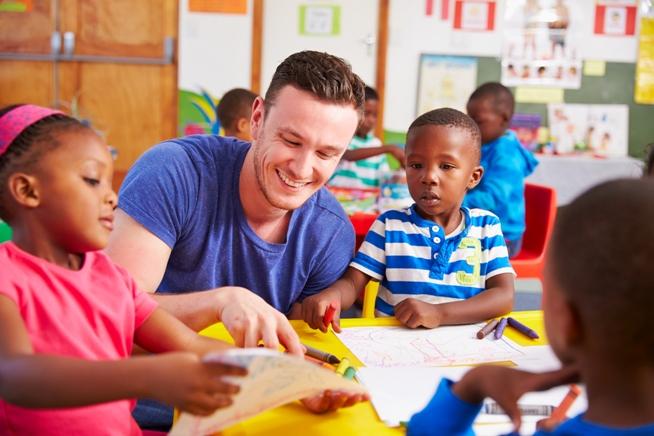
Teachers will appreciate the help, trust us.
I can’t tell you how many parents I’ve volunteered with who seem to be terrified of the children.
Fall carnivals and endless Scholastic book fairs have given elementary school volunteering a bad rap. Any time you’ve got hundreds of kids rushing you — especially when they've got sticky fingers or grubby handfuls of loose change — of course it is going to suck.
But you may have heard about some research on the subject: kids whose parents volunteer at school do better. And people who volunteer live longer. Just saying.
So you want to get involved at school, but feel like it might suck the life out of you? I’m here to help. Here are some suggestions on how to volunteer for events at your kid's school while keeping your sanity intact.
Rule 1: Meet the kids your kid knows.
My main reason for doing reading testing, enduring a bus ride to a field trip about weapons engineering, and other thrills? Stalking. I call it something else, but that’s the gist of it. I want to know these short humans who spend their time with my darling sons. Six or seven hours a day, the other students are chatting and touching and sharing stuff with my kids. And I’m far away with no clue. Being with the class is a great way to get the inside scoop on relationship dynamics. Who is the loud one? Is there a group of snarky girls? How does my kid interact with others?
With some effort, you can even learn names. That is awesome for asking your kid pointed questions instead of a vague "How was your day?" Try something like this: “Who does Savannah hang out with? It seems like she’s a little bossy.”
Wait for the details to roll out, which will give you insight into way more than just Savannah. You’ll see how your child views certain behaviors, notice whom he mentions frequently, that sort of stuff. Having these kind of frequent conversations is also good for the next step...
Rule 2: Talk to the kids.
I can’t tell you how many parents I’ve volunteered with who seem to be terrified of the children. These are people who are responsible for at least one of the students, so they should have some semblance of an idea how to talk to a 9-year-old. But no, they stand awkwardly in the corner and take up space. Maybe they do a task if directly instructed by the teacher.
Interact with the students. My life theory? The more positive adults in a kid’s life, the better. I’m not saying Billy has to become your new best friend and spend every holiday with your family. I’m saying that making jokes, asking questions, and generally showing interest in a child makes them feel good. I don’t discipline or anything, but when helping in the computer lab I’m comfortable telling a kid to get back to work. They usually listen, too — I’ve related to them and been decent in the past, so they figure I deserve a little respect.
I talk to the kids after school when mine aren’t around. Some seem surprised that I know their names outside the classroom. I feel like I might be able to use this to my advantage when they become the skeezy tweens who I see loitering around town.
Rule 3: Remember: It isn’t about you.
I have an advanced degree. And I spend time making photocopies at the school sometimes. Is this the activity I dream of? Hell no — see rules 1 and 2. But I do it. Why? It is what the teacher needs. I want her to spend all her time and energy on teaching. If I can help with the non-teaching parts of her life, I’m happy to do so.
So if you aren’t into worms, but the second grade class is investigating worm castings (true event), suck it up. Don’t be a drama queen. Likewise, don’t spend your volunteer time chatting with the teacher or other adults. And certainly don’t give your child special attention and try to do her work for her.
But definitely try some volunteering. You’ll probably like it. Whether you have time once a year for a big event or can scratch out 30 minutes on Friday afternoons, being at the school shows everyone that you value it. Kids see it, teachers see it, and even you can see that you’ve made it a priority. And that’s good for all of you.

